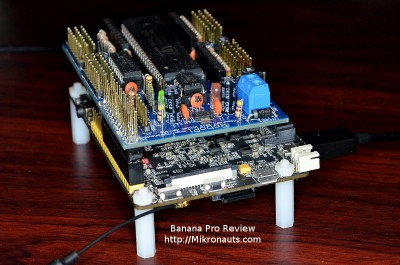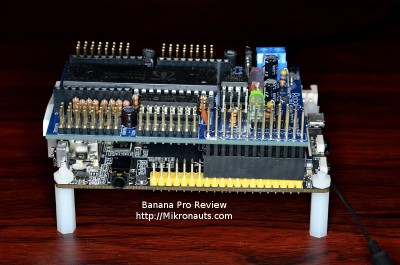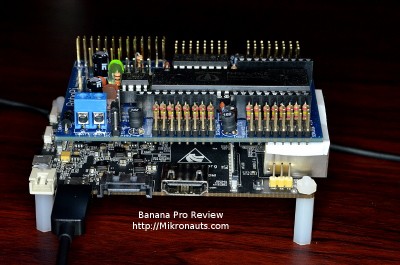Banana Pro Review
WiringPi test:
#include <wiringPi.h>
#include <stdio.h>
int main(int argc, char **argv) {
int i;
if (wiringPiSetup()==-1)
exit(1);
wiringPiSetupGpio();
for(i=22;i<26;i++)
pinMode(i, OUTPUT);
while(1) {
for(i=22;i<26;i++) {
digitalWrite(i,1);
delay(1000);
}
for(i=22;i<26;i++) {
digitalWrite(i,0);
delay(1000);
}
}
}
I compiled and executed it with:
gcc -o test test.c -l wiringPi
sudo ./test
It just worked.
Python test:
Initially, I had problems running the Banana Pi version of RPi.GPIO on the Banana Pro. Basically, the pin numbers did not match exactly, so the BCM I/O mappings were not what I expected.
Fortunately, LeMaker released a new version of RPi.GPIO for the Banana Pro. You can download it from wiki.lemaker.org/RPi.GPIO where you will also find clear instructions building and installing it.
$ sudo python
Python 2.7.3 (default, Mar 18 2014, 05:13:23)
[GCC 4.6.3] on linux2
Type “help”, “copyright”, “credits” or “license” for more information.
BAPI: revision(2)
>>> import RPi.GPIO as io
>>> io.setmode(io.BCM)
>>> io.setup(22,io.OUT)
>>> io.output(22,1)
>>> io.output(22,0)
>>>
The new version worked just fine 🙂
The command line GPIO utility
It just works! You just have to remember to use the ‘-g’ flag (something I forgot during my last late-night test.).
gpio -g mode 22 out
gpio -g mode 23 out
gpio -g mode 24 out
gpio -g mode 25 out
gpio -g write 22 1
gpio -g write 23 1
gpio -g write 24 1
gpio -g write 25 1
gpio readall
will show you the current mode and state of each pin.
4) Multimedia
Video playback has improved since I wrote my Banana Pi review.
https://linux-sunxi.org/CedarX/VideoRenderingChart
shows that 1080p at 25fps is feasible, and LeMaker has released a ‘LeMedia’ image that comes with XBMC pre-installed. There are still some issues, but they are being worked on.
LeMedia thread: https://forum.lemaker.org/thread-9452-1-1-1.html
Another option is Android 4.4 (Beta 1) as apparently the XBMC apk installs cleanly – and it is supposed to work.
Hardware Compatibility
The Banana Pro and Banana Pi are largely hardware compatible with each other, but there are a few differences:
- 40 pin vs. 26 pin GPIO header
- position of the GPIO header is slightly different
- Banana Pro adds an AP6210 WiFi adapter and antenna
- micro USB OTG connector is a bit different (thanks Tony)
RoboPi
RoboPi worked immediately – all I had to change was tell it to use /dev/ttyS2 (Uart 4) for communication. (change /dev/ttyAMA0 to /dev/ttyS2 in the RoboPiInit() calls in the demo programs)
As you can see, RoboPi sits nicely on top of the Banana Pi.
(click on image for larger version)
Here is a side view where you can see that RoboPi sits on only 26 of the 40 GPIO’s.
You can also see some white electrical tape I put on top of the Ethernet and USB jacks to prevent shorts.
(click on image for larger version)
Here is a clearer view of the white electrical tape.
(click on image for larger version)
I was pleased that my existing C and Python support for RoboPi just worked.
Review Index
Page 1: Introduction, Does it look the same?
Page 2: Closer Look at the Banana Pro
Page 3: Feature Comparison, Operating Systems
Page 4: Software Compatibility
Page 5: WiringPi, RPi.GPIO, Hardware Compatibility
Page 6: More hardware compatibility, WiFi Configuration
Page 7: Documentation, Benchmarks
Page 8: Power Utilization, Support, Conclusion



